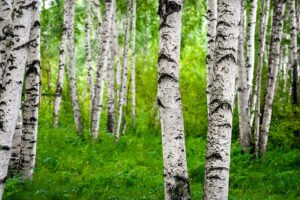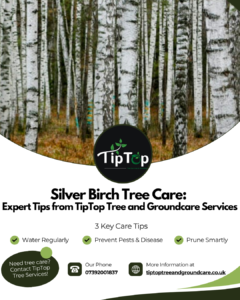Silver birch trees (Betula pendula) are a stunning addition to any landscape, known for their distinctive white bark, delicate foliage, and graceful form. Whether you are a homeowner, gardener, or tree enthusiast, understanding how to care for a silver birch is essential for ensuring its longevity and health.

At TipTop Tree Services, we specialise in expert tree care across the UK. In this comprehensive guide, we’ll explore everything you need to know about silver birch trees, including their characteristics, benefits, planting tips, pruning techniques, and common problems.
1. Overview of Silver Birch Trees
- Scientific Name: Betula pendula
- Common Names: Silver Birch, European White Birch, Weeping Birch
- Family: Betulaceae (Birch family)
- Lifespan: 60–90 years (can exceed 100 years in ideal conditions)
- Growth Rate: Fast-growing (up to 1 metre per year in early years)
2. Characteristics of Silver Birch Trees
Bark
- Distinctive papery white bark that peels in layers.
- Develops dark horizontal fissures and black diamond-shaped cracks with age.
Leaves
- Small, triangular, serrated green leaves that turn golden yellow in autumn.
- Typically 3–7 cm (1.2–2.8 inches) in length.
Flowers & Seeds
- Catkins appear in early spring before the leaves emerge.
- Male catkins: Yellowish, 5–10 cm, pendulous.
- Female catkins: Shorter, greenish, stand upright before developing into seeds.
- Produces tiny, winged seeds that disperse by wind.
Roots
- Shallow but extensive root system.
- Prefers moist, well-drained soils but adapts to poor conditions.
3. Native Habitat & Distribution
Silver birch trees are native to:
- Europe (from Spain to Russia)
- Northern Asia (including Siberia)
- Parts of the UK
They thrive in temperate climates with cold winters and mild summers and are commonly found in woodlands, open fields, and urban landscapes.
4. Benefits of Silver Birch Trees
Environmental Benefits
- Improves Air Quality: Absorbs pollutants and carbon dioxide.
- Prevents Soil Erosion: A strong root system stabilises soil.
- Supports Biodiversity: Provides habitat for birds, insects (e.g. butterflies, moths), and fungi.
Ornamental & Landscaping Uses
- Popular in gardens and parks due to its elegant appearance.
- Used for windbreaks and privacy screens.
Cultural & Historical Significance
- Sacred in Celtic mythology—symbolising renewal and purification.
- Associated with protection and new beginnings in folklore.
- Used in medicinal remedies by indigenous and European cultures.
5. How to Grow & Care for a Silver Birch Tree
Planting
- Best Time: Late autumn to early spring.
- Ideal Location: Full sun to partial shade.
- Soil: Prefers moist, well-draining soil but tolerates poor soil.
- Spacing: At least 5 metres apart for multiple trees.
Watering & Fertilising
- Needs regular watering during dry periods.
- Fertilise in early spring with organic compost or balanced tree fertiliser.
Pruning
- Best Time: Late autumn to early winter (dormant season).
- Why? Avoid excessive sap loss in spring.
- Method: Remove dead or weak branches; thin out overcrowded growth.
Pest & Disease Management
- Common Pests: Birch leaf miner, aphids, bronze birch borer.
- Common Diseases: Fungal infections (e.g. birch dieback), leaf rust, canker.
- Prevention: Proper pruning, well-drained soil, and pest-resistant species.
6. Pruning Your Silver Birch Tree
Why Prune a Silver Birch Tree?
Pruning is essential to:
- Promote Healthy Growth – Removing dead or diseased branches stimulates strong growth.
- Improve Tree Structure & Shape – Enhances airflow and prevents weak branch formations.
- Reduce Safety Hazards – Prevents damage from falling branches in storms.
- Encourage Longevity – Redirects energy to healthier branches.
Best Time to Prune
- Ideal Timing: Late autumn to early winter (dormant season) to prevent excessive sap loss.
- Avoid: Spring and summer pruning as it can weaken the tree and attract pests.
Essential Tools for Pruning
- Sharp Pruning Shears – For small branches up to 2 cm thick.
- Loppers – For medium-sized branches (2–4 cm thick).
- Pruning Saw – For larger branches (over 4 cm thick).
- Pole Pruner – For high branches without needing a ladder.
- Protective Gear – Safety goggles, gloves, and sturdy footwear.
- Disinfectant – Clean tools to prevent disease spread.
Step-by-Step Guide to Pruning
- Remove Dead or Diseased Branches – Cut at a slight angle to prevent water accumulation.
- Thin Out the Canopy – Remove overcrowded branches to improve airflow.
- Trim Low-Hanging Branches – Clear obstructions near pathways and buildings.
- Shape the Tree – Maintain its natural form by trimming only necessary branches.
- Use Proper Cutting Techniques – Cut just outside the branch collar to prevent decay.
- Dispose of Cuttings – Compost small branches or use a wood chipper.
7. Common Problems & Challenges
1. Bronze Birch Borer (Agrilus anxius)
- A serious pest that can kill mature trees by damaging vascular tissues.
- Prevention: Choose borer-resistant birch varieties, maintain healthy soil, and prune weak branches.
2. Birch Leaf Miner
- Larvae feed on leaves, causing premature yellowing and drop.
- Prevention: Use insecticidal soap or neem oil.
3. Fungal Diseases
- Common Issues: Birch dieback, leaf rust, canker.
- Prevention: Maintain good air circulation, avoid overwatering, and remove infected branches.
8. Uses of Silver Birch Trees
1. Timber & Wood Products
- Lightweight, flexible wood used for furniture, plywood, and flooring.
- Historically used for canoes, brooms, and paper.
2. Medicinal Uses
- Birch sap is rich in minerals and is used for detoxification.
- Birch bark has anti-inflammatory properties and is used for wound healing.
3. Birch Sap & Birch Water
- Harvested in early spring and consumed as a refreshing drink.
- Contains antioxidants and electrolytes, making it popular in health drinks.
Expert Silver Birch Tree Services in the UK
 At TipTop Tree Services, we provide professional tree care across the UK. Whether you need expert pruning, tree maintenance, or disease management, our certified arborists ensure the health, safety, and beauty of your silver birch trees.
At TipTop Tree Services, we provide professional tree care across the UK. Whether you need expert pruning, tree maintenance, or disease management, our certified arborists ensure the health, safety, and beauty of your silver birch trees.
📞 Call us for a free tree assessment: 07392001837
🌐 Visit our website: TipTop Tree and Groundcare Services
Trust TipTop Tree Services for all your tree care needs—because healthy trees make for beautiful landscapes!

